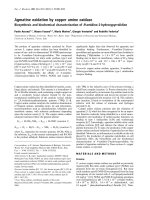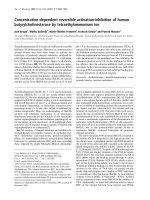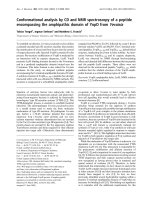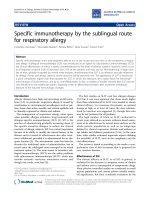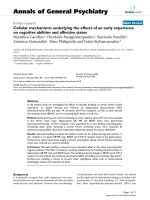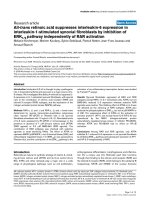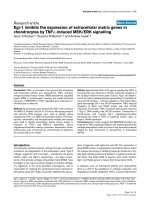Báo cáo y học: "Further benefits by early start of HIV treatment in low income countries: Survival estimates of early versus deferred antiretroviral therapy" potx
Bạn đang xem bản rút gọn của tài liệu. Xem và tải ngay bản đầy đủ của tài liệu tại đây (306.45 KB, 9 trang )
RESEARC H Open Access
Further benefits by early start of HIV treatment in
low income countries: Survival estimates of early
versus deferred antiretroviral therapy
Kjell Arne Johansson
*
, Bjarne Robberstad, Ole Frithjof Norheim
Abstract
Background: International HIV guidelines have recently shifted from a medium-late to an early-start treatment
strategy. As a consequence, more people will be eligible to Highly Active Antiretroviral Therapy (HAART). We
estimate mean life years gained using different treatment indications in low income countries.
Methods: We carried out a systematic search to identify relevant studies on the treatment effect of HAART.
Outcome from identified observational studies were combined in a pooled-analyses and we apply these data in a
Markov life cycle model based on a hypothetical Tanzanian HIV population. Survival for three different HIV
populations with and without any treatment is estimated. The number of patients included in our pooled-analysis
is 35 047.
Results: Providing HAART early when CD4 is 200-350 cells/μl is likely to be the best outcome strategy with an
expected net benefit of 14.5 life years per patient. The model predicts diminishing treatment benefits for patients
starting treatment when CD4 counts are lower. Patients starting treatment at CD4 50-199 and <50 cells/μl have
expected net health benefits of 7.6 and 7.3 life years. Without treatment, HIV patients with CD4 counts 200-350; 50-
199 and < 50 cells/μl can expect to live 4.8; 2.0 and 0.7 life years respectively .
Conclusions: This study demonstrates that HIV patients live longer with early start strategies in low income
countries. Since low income countries have many constraints to full coverage of HAART, this study provides input
to a more transparent debate regarding where to draw explicit eligibility criteria during further scale up of HAART.
Background
The optimal time to start treatment for HIV/AIDS has
been a contentious issue since the introduction of
Highly Active Antire troviral Treatm ent (HAART). Initi-
ally a “hit hard and early” strategy was promoted [1].
Because of concerns about long term toxicity and fear
of developing drug resistant viruses, delayed treatment
starts were later recomme nded in clinical guidelines [2].
The delayed treatment policy implied that, in the
absence of particular disease manifestations, treatment
should not be started before CD4 counts dropped below
200 cells/μl. However, recent evidence indicates that this
policy reduces survival compared to earlier treatment
start. The World Health Organisation (WHO) revised
the ART guidelines for resource constrained settings
accordingly and re-introduced a “ hit hard and early”
strategy. In the revised 2009 guidelines, it is recom-
mended that HAART is initiated on all HIV patients
with CD4 counts below 350 cells/μl, regardless of symp-
toms [3]. Despite this change of recommendations, few
low income countries have revised the national ART
guidelines and many still recommend that initiation of
HAART in asympto matic HIV-infected persons are
delayed until the CD4 count drops below 200 cells/μl
[4]. Recent evidence from high income countries sup-
port even earlier initiation of treatment - before CD4
count drops below 350 cells/μl [5,6]. A clinical trial in
Haiti recently demonstrated that deferring treatment
until CD4+ T cell counts drops below 200 cells/μl,
rather than providing HAART at CD4 counts between
200 and 350 cells/μl, increases death risk nearly four
* Correspondence:
University of Bergen, Department of Public Health and Centre for
International Health, Research Group in Global Health: Ethics, Economics and
Culture, PB 7804, 5020 Bergen, Norway
Johansson et al. AIDS Research and Therapy 2010, 7:3
/>© 2010 Jo hansson et al; licensee BioMed Central Ltd. This is an Open Access article distributed under the terms of the Creative
Commons Attribution License ( y/2.0), which permits unrestrict ed use, distribution, and
reproduction in any medium, provided the original work is properly cited.
times [7]. However, there is little information to guide
this important clinical decision in low income settings.
The debate regarding optimal timing of treatment
start has tremendous implications for HAART demand,
and subsequently, on the estimated treatment coverage
in different settings. Towards the end of 2008, only 3
million people out of 33 million with HIV were given
HAART [8]. In l ow income countries, treatment is still
mainly provided to the sickest patients. Median baseline
CD4 counts at initiation of HAART have been found to
be between 100-150 cells/μl in several low income coun-
tries [9-15]. In contrast, a population based study from
2007 indicates that 42% of all HIV patients in Malawi
had a CD4 cell count under 350 cells/μl, while 22% had
under 200 cells/μl [16]. Shifts to an early treatment start
strategy will increase the need for HAART, but few peo-
pleactuallyreceiveHAART.Becauseofthehugegap
between treatment coverage and needs, health outcomes
from different treatment indications need to be assessed
systematically.
Life years g ained by different CD4 starting points is
necessary information for making informed choices
about early or late start of treatment. Studies in low
income countries have found that patients starting
HAART early (CD4 <350 cells/ μl) have life expectancies
from 9.4 to 17.2 life years and that life expectancies are
6.8 - 14.9 with late treatment strategies (CD4 < 200 cells/
μl) [17-22]. Only one study adjust for lead time bias and
report the size of the health benefit from the treatment;
Cleary et.al. found that HAART yielded a net health ben-
efit of 10 life years when it was initiated at the point
when CD4 was below 200 cells/μl.Theincreaseinthe
length of survival for patients starting treatment in earlier
stages of HIV may reflect either earlier treatment initia-
tion or delay in time of death. Therefore, to avoid overes-
timates of the actual impact of early treatment start, it is
necessary to eliminate this potential confounding effect,
which is often referred to as lead time bias. A recent
eART-linc collaboration study found lead t ime to be as
long as 4.6 life years [23]. Studies need to adjust for lead
time bias and report net life years gained from different
starting strategies in order to provide adequate informa-
tion to make a ratio nal clinical decision on th is issue in a
low income setting.
Ouroverallaimistoinformtheethicaldilemmaof
choosing between providing HIV treatment to patients
with potential best outcomes and giving fair chances to
the more severely ill patients with less potential benefi t.
The objective of this study is therefore to estimate the
life years gained with early and late treat ment strategies
in low income countries. In the absence of randomized
clinical trials, we model life years gained by using best
available evidence from observational studies.
Methods
We did a structured literature review and combined find-
ings in a pooled-analysis to find the bes t evidence under-
lying the different treatment strategies. Based on these
findings, a Markov life cycle model was constructed to
estimate the expected remaining life years with and with-
out HAART stratified in three baseline CD4 strata at the
time patients first present for care: CD4 <50 cells/μlor
50-199 cells/μl or 200-350 cells/μl. The m odel can be
appli ed on any population, and we test it on a Tanzan ian
HIV population since information on HIV prevalence
and life tables were easily ava ilable [ 24,25]. We elim inate
lead time bias by calculating survival with and without
treatment for three CD4 strata, representing three differ-
ent stages of the disease, and subtracting a stratified net
health benefit for each CD4 strata.
The set of mutually exclusive health states in the
mod el and the various events that can occur in the his-
tory of HIV are illustrated in Figure 1. In our model, all
patients have CD4 counts below 350 cells/μlandare
assigned to the initial health states called “CD4 200-350
and alive” , “CD4 50-199 and alive” or “CD4 <50 and
alive” . The Markov-cycle tree model is evaluated by
expected value simulation, and a cycle le ngth of one
year is applied. At the end of each cycle, patients may
continue in the initial health state or move from one
state to either of the two events called “ HIV related
death” or “Age related death” or to a lower CD4 stra-
tum, according to transition probabilities (see below).
We considered 100 Markov cycles (years) to ensure that
the whole cohort has moved to the death state by the
end of the analysis. We incorporate dynamic changes in
CD4 cell count occurring after patients enter the model
for those not initiating HAART. We did not allow HIV
patients initiating HAART to jump down to lower CD4
strata since studies indicate a large CD4 recovery the
first four years after HAART initiation [26]. The effect
from this CD4 recov ery will be incorporated in the
pooled HIV-related mortality-rates.
Model parameters
We assume th at patients presenting for care have a
mean age of 35 years because this agreed with the char-
acteristics of the underly ing HIV demographics in the
region and mean age of the studies included in the
pooled-analysis (tables 1 and 2). We only included HIV
populations with CD4 counts < 350 cells/μl.
To identify e vidence used as input in our a nalysis we
carried out searches in the Cochrane Database of Sys-
tematic Reviews (inception to first quarter 2009), Ovid
Medline (1996 to March 2009), EMBASE (inception to
March 2008), ISI Web of Science (1992 to March 2008),
conference abstracts from the International AIDS
Johansson et al. AIDS Research and Therapy 2010, 7:3
/>Page 2 of 9
Society (2006 to 2008), the Conference on Retroviruses
and Opportunistic Infections (inception to 2009) and
the HIV Implementers’ Meetings (2006-2008). Refer-
ences from relevant papers were also “hand” searched.
Search terms were; “HIV, Africa, low income countries,
mortality & survival”. Only Engl ish langua ge papers were
reviewed. Eligible studies were identified by the first
author and their relevance confirmed by the other
authors. Inclusion criteria for the structured review are:
low income countries, randomised controlled trial or
observational studies with minimum one year observa-
tional period, effect measure s that coul d be converted to
one year absolute risk of death, death r isks stratified int o
baselineCD4strata<50or50-199or200-350cells/μl,
information o n number of participants in the various
CD4 strata and participants older than 15 years of age.
We found no published randomised controlled trials
evaluating the effect of different starting points versus pla-
cebo in low income countries. It is considered unethical to
conduct su ch tria ls toda y. An alysis must therefo re draw
CD4 200-350
and alive
HIV r elated death
CD4 50-199
and alive
CD4 <50
and alive
Dead
Age related death
Figure 1 Markov state transition diagram illustrating the life cycle model used to calculate the effects of the three alternative
interventions. Each oval represents a health state in the Markov model. During each successive year, patients may continue in their present
health state, die from HIV or age related death (and transition to a death state). Patients not initiating HAART may also jump to lower CD4
states.
Table 1 Pooled-analysis of one-year HIV-related mortality rates for HIV patients not taking HAART stratified in three
baseline CD4 strata.
Study n Median age Weight (%) Absolute risk of death per year (95% CI)
Baseline CD4 count <50
Thailand (40) 345 NA 1.00 0,796 (0,697 - 0,894)
Weighted mean (weighted CI) 345 0,796 (0,697 - 0,894)
Baseline CD4 count 50-199
South Africa (39) 361 NA 0.22 0,192 (0,154 - 0,234)
Thailand (40) 77 NA 0.05 0,216 (0,135 - 0,298)
South Africa (41) 668 32 0.41 0,270 (0,230 - 0,330)
Thailand (42) 227 26-29 0.14 0,278 (0,250 - 0,313)
Uganda (46) 78 30 0.05 0,532 (0,421 - 0,643)
Gambia (45) 221 30 0.14 0,941 (0,801 - 1,080)
Weighted mean (weighted CI) 1632 0,355 (0,335 0,375)
Baseline CD4 count 200-350
South Africa (39) 206 NA 0.14 0,088 (0,057 - 0,128)
Thailand (40) 192 NA 0.13 0,077 (0,047 - 0,107)
South Africa (41) 326 32 0.23 0,080 (0,050 - 0,120)
Thailand (42) 467 26-29 0.32 0,104 (0,100 - 0,128)
Uganda (46) 81 30 0.06 0,175 (0,092 - 0,258)
Gambia (47) 175 30 0.12 0,207 (0,160 - 0,254)
Weighted mean (weighted CI) 1447 0,109 (0,093 - 0,125)
NA = Not Available
Johansson et al. AIDS Research and Therapy 2010, 7:3
/>Page 3 of 9
Table 2 Pooled-analysis of one-year HIV-related mortality rates for HIV patients initiating HAART at CD4 counts <50,
50-199 and 200-350 cells/μl.
Study n Median age Weight (%) Absolute risk of death per year (95% CI)
Baseline CD4 count <50
Year 1 on HAART
ART LINC (12) 1474 36 0.18 0,062 (0,049 - 0,074)
Senegal (24) 96 37 0.01 0,179 (0,115 - 0,272)
South Africa (30) 155 31 0.02 0,182 (0,13 - 0,253)
Cambodia (ref) 416 33.6 0.05 0,130 (0,100 - 0,170)
Botswana 2 (Wester) 43 36 0.01 0,240 (0,116 - 0,355)
Côte d’Ivoire (23) 2655 36 0.33 0,230 (0,200 - 0,250)
Botswana 1 (Mujugira) 349 35 0.04 0,340 (0,288 - 0,388)
Zambia (29) 2797 35 0.35 0,308 (0,291 - 0,325)
Weighted mean (weighted CI) 7985 0,224 (0,215 - 0,233)
Year 2+ on HAART
Senegal (24) 79 37 1.00 0,088 (0,026 - 0,150)
Weighted mean (weighted CI) 79 0,088 (0,026 - 0,150)
Baseline CD4 count 50-199
Year 1 on HAART
ART LINC (12) 2022 36 0.10 0,030 (0,022 - 0,037)
West-Africa (25) 232 34 0.01 0,050 (0,026 - 0,087)
Senegal (27) 176 38 0.01 0,074 (0,052 - 0,105)
Botswana 2 (Wester) 87 36 0.00 0,097 (0,035 - 0,156)
Haiti (28) 1004 NA 0.05 0,140 (0,117 - 0,162)
Senegal (24) 177 37 0.01 0,131 (0,089 - 0,190)
South Africa (30) 132 31 0.01 0,086 (0,049 - 0,151)
South Africa (39) 81 NA 0.00 0,069 (0,031 - 0,133)
Côte d’Ivoire (23) 7556 36 0.39 0,090 (0,070 - 0,110)
Zambia (29) 6787 35 0.35 0,140 (0,132 - 0,148)
Malawi (ref) 1298 34.9 0.07 0,190 (0,170 - 0,190)
Weighted mean (weighted CI) 19552 0,110 (0,106 - 0,114)
Year 2+ on HAART
Malawi (ref) 1051 34.9 0.87 0,09 (0,070 - 0,110)
Senegal (24) 154 37 0.13 0,06 (0,025 - 0,095)
Weighted mean (weighted CI) 1205 0,088 (0,072 - 0,104)
Baseline CD4 count 200-350
Year 1 on HAART
ART LINC (12) 940 36 0.23 0,011 (0,004 - 0,017)
West-Africa (25) 408 34 0.10 0,017 (0,006 - 0,038)
Senegal (24) 122 37 0.03 0,058 (0,028 - 0,119)
South Africa (39) 110 NA 0.03 0,014 (0,002 - 0,049)
Zambia (29) 2506 35 0.61 0,094 (0,083 - 0,105)
Weighted mean (weighted CI) 4086 0,064 (0,057 - 0,071)
Year 2+ on HAART
Senegal (24) 115 37 1.00 0,024 (-0,004 - 0,052)
Weighted mean (weighted CI) 115 0,024 (-0,004 - 0,052)
NA = Not Available
Johansson et al. AIDS Research and Therapy 2010, 7:3
/>Page 4 of 9
on the best available evidence from observational studies.
We found no controlled observational studies, that is, stu-
dies comparing survival between an intervention and a
control group. Effect size in terms of life expectancy can
therefore only be evaluated through modelling. We identi-
fied six observational studies showing survival before
initiation of HAART in low-income settings with accurate
information on stratified survival according to baseline
CD4 count (table 1); two from South Africa [27,28] and
Thailand [29,30] and one from Uganda [31] and Gambia
[32]. We found 13 observational studies showing survival
after HAART in low-income settings with accurate infor-
mation on stratified survival according to baseline CD4
count at start of HAART (table 2); two from Senegal
[13,33], South Africa [27,34] and Botswana [35,36] and
one from Cambodia [37], Côte d’Ivoire [38], Zambia [12],
West-Africa [15] Haiti [39] and Malawi [14] and one mul-
ticentre study from several low income countries (ART
LINC) [9]. The number of patients included in our
pooled-analysis is 35 047.
The principal outcome measure in t he pooled-analysis
(tables 1 and 2) is one year absolute mortality risk for
HIV patients with no treatment or on HAART for var-
ious baseline CD4 strata. We extracted information on
absolute mortality risk from relevant studies either
through assessment of estimates reported in tables or
estimation from Kaplan-Meie r curves. The outcome
measures and 95% confidence intervals were calculated
for the individual studies and the pooled-analysis exam-
ined the overall outcome (tables 1 and 2). We combined
the results by calculating weighted probability (p
w
)and
confidence intervals (CI) as follows:
p
n
i
p
i
i
n
n
i
i
n
and SE p
n
i
p
i
p
i
i
n
n
i
i
n
a
ww
=
=
∑
=
∑
=
−
=
∑
=
∑
2
1
1
1
1
1
()
()
()
nnd
CI P SE p
ww
95 1 96%.*()=±
Where p
w
is the weighted p robabilities, n
i
denote
number of individuals in i-th study, and p
i
represent the
probability of death in the i-th study.
We combine mortality rates with a weighted mean
rather than a narrative syntheses or simple mean
because larger sample size (n) increases the chance the
sample is repr esentative and leads to increased precision
in estimates. Hence, more weight should be given to
large sample size. Weighted probabilities were used as
transition probabilities in the Markov model. The effect
size measure between studies in the Markov model was
net life years gained and total remaining life years.
For patients not receiving HAART we assumed con-
stant annual mortality rates of 0.796, 0.355 and 0.109
for the CD4 health states <50, 50-199 and 200-350,
respectively (table 1). We applied a CD4 decline r ate of
22 cells/μl, which draws on a Tanzanian observational
study [40]. The one-year transition rate from one CD4
level to a lower level was calculated by dividing the
baseline CD4 difference in each stratum with the annual
CD4 decline rate. All treatment studies with more than
one year observational period documented a peak in
mortality the first year. Studies from high income coun-
tries have also documented a decreasing death risk for
patients on HAART after the first year of treatment
[41]. We applied a similar peak in our model, with
higher HIV-related mortality rates the first year after
HAART initiation, according to the findings in the
pooled-analysis. From year three and onwards, we
assumed constant HIV-related mortality, with year two
as the annual mortality rate. We found no evidence on
temporal treatment outcomes fr om year three and
onwards to inform differently.
One-way sensitivity analyses (table 3) identified effects
of applying low and high mortality rates and ages in the
Markov model. High and low mortality rates in the sen-
sitivity analyses are based on upper and lower values of
the 95% weighted confidence intervals.
A Tanzanian life table from 2006 with average life
expectancy at age of 35 of 28.2 years for both sexes was
used to adjust for the age related bac kground mortality
[24]. The life table reflects the average mortality risks of
both infected and uninfected persons in various age
groups, and the background mortality was therefore
adjusted for the probability of death with no HAART pre-
sented in table 1. Adjusted non HIV related mortality was
calculated for each age as follows: Total background mor-
tality in the life table - (HI V related mortality * HIV
prevalence).
The adult (15-50 years) HIV prevalence in Tanzania is
5.7% and it is estimated that 2.2 million people are liv-
ing with HIV [25]. To our knowledge, there is only one
population based study from a low income setting
describing the distribution of CD4 counts in a non trea-
ted HIV population [16]. Based on this study from
Malawi, we assumed that 22% and 20% out of all HIV
patients have CD4 c ounts 200-350 and < 200 cells/μl,
respectively. Since the study did not report the propor-
tion of HIV patients with CD4 < 50 cells/μl, we assumed
a lower proportion in the lowest CD4 strata due to the
increased mortality rate. We assumed that among the
patients with CD4 <200 cells/μl, 80% had CD4 counts
50-199 cells/μl and 20% had CD4 counts <50 cells/μl.
Results
We calculated expected remaining life years without
HAART and net life years gained from HAART b y dif-
ferent CD4 starting points (figure 2). From figure 2 it
Johansson et al. AIDS Research and Therapy 2010, 7:3
/>Page 5 of 9
can be seen that the sick est patients have 0.7 remaini ng
life years without treatment and net life years gained
from HAART is 7.2 life years. Patients with CD4 counts
50-199 cells/μl are expected to live 2.0 life years without
treatment and have a net health benefit of 7.6 life years
from HAART. Patients with CD4 counts 200-350 cells/
μl have 4.8 remaining life years without treatment and
gain an extra 14.5 life years with early treatment start.
Results from the one-way sensitivity analyses are
shown in table 3, and show that outcomes are highly
sensitive to assumptions about death risk for patients
receiving HAART. High and low values of death risks
with and without HAART were taken from the upper
and lower bounds of the weighted 95% confidence inter-
vals of the pooled-analysis. Applying the most optimistic
reducti ons in death risks from HAART yields estimated
survival of 24.3, 9.2 and 14.5 life years per person if
starting HAART at CD4 200-350, CD4 50-199 and <50
cells/μl, respectively. The corresponding figures using
the most pessimistic death risks were 8.5, 6.4 and 4.4
life years. The effects of death risks without treatment,
and assumptions about mean age of patients were also
tested. Outcomes turned out to be much less sensitive
to these assumptions (table 3).
Discussion
Our study suggests that providing HAART early is likely
to yield most life years if everyone receives treatment.
This is in concordance with the recommendations in
the revised 2009 WHO guidelines. However, few gov-
ernments in low income countries are capable of provid-
ing optimal treatment to all if everyone with CD4 < 350
cells/μl are considered to be eligible. Given the severe
budget constraints low income countries face, a policy
wherefewerpatientsareconsideredtobeeligibleisthe
more common practice.
In terms of stratified net life years gained from
HAART, we believe our study to be unique. From inter-
national published databases, we were unable to identify
any studies which describe stratified net life years gained
from HAART with various starting points. Five studies
reported life expectancy for HIV patients when starting
treatment at CD4 < 200 cells/μl and results ranged from
6.8 life years to 14.9 life years, which is comparable to
our total survival (without treatment + HAART) of 9.6
life years in figure 2[17,19-22]. Four studies reported life
expectancy when starting HAART at CD4 < 350 cells/μl
and results ranged from 9.4 to 17.2 life years, which is
slightly lower than our total survival of 19.3 life years
(figure 2) [17,18,20,22]. However, our estimated health
benefit from HAART was reduced to 14.5 life years (fig-
ure 2) when we adjusted for lead time bias. One study
reported life years gained by increasing HAART initia-
tion threshold from CD4 counts below 250 to 350 cells/
μl, and found undiscounted survival gain to be 1.04 life
Table 3 One-way sensitivity analysis and impact on remaining life years without treatment + net benefit from HAART
for HIV patients in three CD4 strata.
Remaining life years without treatment + net benefit from HAART
Variable CD4 <50 CD4 50-199 CD4 200-350
Base case 0.7 + 7.2 2.0 + 7.6 4.8 + 14.5
Low HIV-related mortality rate (HAART) 0.7 + 14.5 2.0 + 9.2 4.8 + 24.3
High HIV-related mortality rate (HAART) 0.7 + 4.4 2.0 + 6.4 4.8 + 8.5
High HIV-related mortality rate (no treatment) 0.9 + 7.0 2.1 + 7.4 5.2 + 13.9
Low HIV-related mortality rate (no treatment) 0.6 + 7.4 1.9 + 7.8 4.4 + 15.1
Start age 30 0.7 + 7.5 2.0 + 8.0 4.8 + 15.9
Start age 40 0.7 + 7.0 2.0 + 7.2 4.7 + 13.2
Low and high values of mortality rates refer to upper and lower 95% CI of the combined weighted pooled estimates in table 1 an d table 2.
CD4 <50 CD4 50-199 CD4 200-350
0.0
2.0
4.0
6.0
8.0
10.0
12.0
14.0
16.0
18.0
20.0
0.7
2.0
4.8
7.2
7.6
14.5
Remaining life
years no
treatment
Life years
gained from
HAART
Figure 2 Mean remaining life years without treatment and life
years gained from HAART stratified in three baseline CD4
ranges.
Johansson et al. AIDS Research and Therapy 2010, 7:3
/>Page 6 of 9
years [18]. This is lower than our estimated 6.9 life years
and could be explained by the fact that we apply a
threshold of 200 cells/μl rather than 250 cells/μl.
The Tanzanian ART guideline from 2005, which is still
being used in 2009, recommends treating asymptomatic
patients when the CD4 count drops below 200 cells/μl
[42]. Asymptomatic patients with higher CD4 counts and
greater potential to benefit may be excluded. The revised
2009 WHO guideline considers all patients with CD4
counts below 350 cells/μl eligible for treatment, no
patient groups are excluded. This goal is ambitious for
reso urce constrained settings, and implies that up to 573
000 adult HIV patients would be eligible for HAART in
Tanzania. Much more resources would be needed to
scale up national ART programs to this level [43].
Strengths and weaknesses of our analysis
A major strength of our analysis is its’ simplicity and use
of evidence-based transition probabilities. The disadvan-
tage of this approach is that we were not able to model
the dynamic changes in CD4 counts for patients on
HAART, which has been done in several recen t studies
[17,19-21]. The model cannot therefore be used to look at
the development of the patient cohort in more detail. For
example, the analysis only includes hard endpoints (death)
and not the whole spectre of clinical events and health
related quality of life that affects HIV patients.
A second strength is that the ana lysis includes the
death risk from observational studies with more than
one year observational period. This enabled us to
include variations in death risks during the first two
years and to reduce the effect of the high mortality peak
often observed during the first 6-12 months after
patients have started HAART.
Death risk from year two and onwards for patients
with CD4 <50 on HAART (table 2) is low and therefo re
the analysis yields a high benefit from HAART for this
patient group. From our sensitivity analysis (table 3) we
see that remaining life years varies the most for patients
receiving HAART with baseline CD4 <50 or 200-350
cells/μl. This is due to few observational studies looking
at absolute death risk from year two and onwards for
these patients, and that the weighted confidence inter-
vals therefore were wider.
Finally, we applied age-related background mortality in
order to provide a more precise estimate of the long term
effects of HAART. However, it is uncertain at what
extent the pooled HIV-related mortality rates incorporate
a long term epidemiological shift for HIV patients.
Conclusion
This study demonstrates that HIV patients live longer
with early start of antiretroviral treatment in low income
countries, and highlights the ethical dilemma of choos-
ing between providing HIV treatment to patients with
potential best outcomes and giving fair chances to all
the more severely ill patients with less potential benefi t.
Since low income countries have many constraints to
full coverage of HAART and more people will be eligi-
ble with an early start strategy, the results of this study
is a good starting point for a more transparent and rea-
soned debate when drawing explicit eligibility criteria
during further scale up of HAART.
Statements
Copyright
The Corresponding Author Kjell Arne Johansson has
the right to grant on behalf of all authors and does
grant on behalf of all authors.
Ethics approval
This study did not involve patients or sensitive informa-
tion about patients and did not therefore require ethical
approval.
Acknowledgements
Thanks to Ingrid Miljeteig, Nir Eyal and the researc h group in Global Health:
Ethics, economics and culture at the University of Bergen, for comments on
earlier drafts and to Roy Miodini Nilsen and Stein Atle Lie for statistical
support.
Johansson was funded by the University of Bergen, while Norheim and
Robberstad were funded by a “Young Investigator Award” grant from the
Norwegian Research Council. The funding agreement ensured the authors’
independence in designing the study, interpreting the data, writing, and
publishing the report.
Authors’ contributions
All authors fulfill the criteria of authorship and contributed collaboratively to
conception and design, analysis and interpretation of data, drafting the
article, revising it critically for important intellectual content and final
approval of the version to be published. We assure that there is no one else
who fulfils the criteria of authorship that has not been included as an
author.
KAJ was principal investigator, designed the study, performed the systematic
literature search, developed the Markov model, led the analysis, and was
lead author for the paper. BR was a co-investigator and participated in the
planning, analysis and writing of the paper. OFN sought funding for the
study, contributed to design, planning, analysis and writing of the paper. All
authors read and approved the final manuscript.
Competing interests
The authors declare that they have no competing interests.
Received: 6 August 2009
Accepted: 16 January 2010 Published: 16 January 2010
References
1. Ho DD: Time to Hit HIV, Early and Hard. N Engl J Med 1995, 333:450-451.
2. Yeni PG, Hammer SM, Hirsch MS, Saag MS, Schechter M, Carpenter CC,
Fischl MA, Gatell JM, Gazzard BG, Jacobsen DM, Katzenstein DA,
Montaner JS, Richman DD, Schooley RT, Thompson MA, Vella S,
Volberding PA: Treatment for adult HIV infection: 2004 recommendations
of the International AIDS Society-USA Panel. JAMA 2004, 292:251-265.
3. World Health Organisation: Rapid advice: antiretroviral therapy for HIV
infection in adults and adolescents. 2009.
Johansson et al. AIDS Research and Therapy 2010, 7:3
/>Page 7 of 9
4. Raizes E, Lindegren M, Ellerbrock T, Ferris R, Marston B: A Comparison of
the Adult National Antiretroviral Therapy (ART) Guidelines of 15 PEPFAR
Focus Countries. 2008.
5. Sabin CA, Phillips AN: Should HIV therapy be started at a CD4 cell count
above 350 cells/microl in asymptomatic HIV-1-infected patients?. Curr
Opin Infect Dis 2009, 22:191-197.
6. Kitahata MM, Gange SJ, Abraham AG, Merriman B, Saag MS, Justice AC,
Hogg RS, Deeks SG, Eron JJ, Brooks JT, et al: Effect of Early versus Deferred
Antiretroviral Therapy for HIV on Survival. N Engl J Med 2009,
360:1815-1826.
7. Starting Antiretroviral Therapy Earlier Yields Better Clinical Outcomes .
2009 />8. UNAIDS: AIDS epidemic update. 2008.
9. Braitstein P, Brinkhof M, Dabis F, Schechter M, Boulle A, Miotti P, Wood R,
Laurent C, Sprinz E, Seyler C, Bangsberg DR, Balestre E, Sterne JA, May M,
Egger M, Antiretroviral Therapy in Lower Income Countries (ART-LINC)
Collaboration; ART Cohort Collaboration (ART-CC) groups: Mortality of HIV-
1-infected patients in the first year of antiretroviral therapy: comparison
between low-income and high-income countries. The lancet 2006,
367:817-824.
10. Lawn SD, Harries AD, Anglaret X, Myer L, Wood R: Early mortality among
adults accessing antiretroviral treatment programmes in sub-Saharan
Africa. AIDS 2008, 22:1897-1908.
11. Lawn SD, Myer LL, Orrell CC, Bekker LG, Wood RR: Early mortality among
adults accessing a community-based antiretroviral service in South
Africa: implications for programme design. AIDS 2005, 19:2141-2148.
12. Stringer JSA, Zulu I, Levy J, Stringer EM, Mwango A, Chi BH, Mtonga V,
Reid S, Cantrell RA, Bulterys M, Saag MS, Marlink RG, Mwinga A,
Ellerbrock TV, Sinkala M: Rapid Scale-up of Antiretroviral Therapy at
Primary Care Sites in Zambia: Feasibility and Early Outcomes. JAMA 2006,
296:782-793.
13. Etard J, Ndiaye I, Thierry-Mieg M, Guèye N, Guèye P, Lanièce I, Dieng A,
Diouf A, Laurent C, Mboup S, Sow PS, Delaporte E: Mortality and causes of
death in adults receiving highly active antiretroviral therapy in Senegal:
a 7-year cohort study. AIDS 2006, 12:1181-1189.
14. Ferradini L, Jeannin A, Pinoges L, Izopet J, Odhiambo D, Mankhambo L,
Karungi G, Szumilin E, Balandine S, Fedida G, Carrieri MP, Spire B, Ford N,
Tassie JM, Guerin PJ, Brasher C: Scaling up of highly active antiretroviral
therapy in a rural district of Malawi: an e ffectiveness assessment. The
Lancet 2006, 367:1335-1342.
15. Moh R, Danel C, Messou E, Ouassa T, Gabillard D, Anzian A, Abo Y,
Salamon R, Bissagnene E, Seyler C, Eholié S, Anglaret X: Incidence and
determinants of mortality and morbidity following early antiretroviral
therapy initiation in HIV-infected adults in West Africa. AIDS 2007,
30:2483-2491.
16. McGrath N, Kranzer K, Saul J, Crampin AC, Malema S, Kachiwanda L, Zaba B,
Jahn A, Fine PE, Glynn JR: Estimating the need for antiretroviral treatment
and an assessment of a simplified HIV/AIDS case definition in rural
Malawi. AIDS 2007, 21(Suppl 6):S105-113.
17. Vijayaraghavan A, Efrusy MB, Mazonson PD, Ebrahim O, Sanne IM,
Santas CC: Cost-effectiveness of alternative strategies for initiating and
monitoring highly active antiretroviral therapy in the developing world.
J Acquir Immune Defic Syndr 2007, 46
:91-100.
18. Walensky RP, Wolf LL, Wood R, Fofana MO, Freedberg KA, Martinson NA,
Paltiel AD, Anglaret X, Weinstein MC, Losina E, for the CII: When to Start
Antiretroviral Therapy in Resource-Limited Settings. Ann Intern Med 2009,
151:157-166.
19. Goldie SJ, Yazdanpanah Y, Losina E, Weinstein MC, Anglaret X, Walensky RP,
Hsu HE, Kimmel A, Holmes C, Kaplan JE, Freedberg KA: Cost-effectiveness
of HIV treatment in resource-poor settings–the case of Cote d’Ivoire. N
Engl J Med 2006, 355:1141-1153.
20. Walensky R, Weinstein M, Yazdanpanah Y, Losina E, Mercincavage L,
Touré S, Divi N, Anglaret X, Goldie S, Freedberg K: HIV drug resistance
surveillance for prioritizing treatment in resource-limited settings. AIDS
2007, 11:973-982.
21. Cleary SM, McIntyre D, Boulle AM: The cost-effectiveness of antiretroviral
treatment in Khayelitsha, South Africa–a primary data analysis. Cost Eff
Resour Alloc 2006, 4:20.
22. Bachmann M: Effectiveness and cost effectiveness of early and late
prevention of HIV/AIDS progression with antiretrovirals or antibiotics in
Southern African adults. AIDS care 2006, 18:109-120.
23. The eligibility for A. R. T. in lower income countries collaboration: Duration
from seroconversion to eligibility for antiretroviral therapy and from ART
eligibility to death in adult HIV-infected patients from low and middle-
income countries: collaborative analysis of prospective studies. Sex
Transm Infect 2008, 84:i31-36.
24. World Health Organisation: 2009 />life_tables/life_tables.cfm.
25. Tanzania Commission for AIDS (TACAIDS), Zanzibar AIDS Commission (ZAC),
Tanzania National Bureau of Statistics, Macro International Inc: Tanzania
HIV/AIDS and Malaria Indicator Survey 2007-08. 2008.
26. Lawn SD, Little F, Bekker LG, Kaplan R, Campbel E, Orrell C, Wood R:
Changing mortality risk associated with CD4 cell response to
antiretroviral therapy in South Africa. AIDS 2009, 23:335-342.
27. Badri M, Bekker LG, Orrell C, Pitt J, Cilliers F, Wood R: Initiating highly
active antiretroviral therapy in sub-Saharan Africa: an assessment of the
revised World Health Organization scaling-up guidelines. Aids 2004,
18:1159-1168.
28. Badri M, Lawn SD, Wood R: Short-term risk of AIDS or death in people
infected with HIV-1 before antiretroviral therapy in South Africa: a
longitudinal study. Lancet 2006, 368:1254-1259.
29. Pathipvanich P, Ariyoshi K, Rojanawiwat A, Wongchoosie S, Yingseree P,
Yoshiike K, Warachit P, Sawanpanyalert P: Survival benefit from non-highly
active antiretroviral therapy in a resource-constrained setting. Journal of
acquired immune deficiency syndromes 2003, 32:157-160.
30. Costello C, Nelson KE, Suriyanon V, Sennun S, Tovanabutra S, Heilig CM,
Shiboski S, Jamieson DJ, Robison V, Rungruenthanakit K, Duerr A: HIV-1
subtype E progression among northern Thai couples: traditional and
non-traditional predictors of survival. Int J Epidemiol 2005, 34:577-584.
31. French NN, Mujugira AA, Nakiyingi JJ, Mulder DD, Janoff EEN, Gilks CCF:
Immunologic and clinical stages in HIV-1-infected Ugandan adults are
comparable and provide no evidence of rapid progression but poor
survival with advanced disease. Journal of acquired immune deficiency
syndromes 1999, 22:509-516.
32. Schim van der Loeff MF, Jaffar S, Aveika AA, Sabally S, Corrah T, Harding E,
Alabi A, Bayang A, Ariyoshi K, Whittle HC: Mortality of HIV-1, HIV-2 and
HIV-1/HIV-2 dually infected patients in a clinic-based cohort in The
Gambia. AIDS 2002, 16:1775-1783.
33. Laurent C, Ngom Gueye N, Ndour C, Gueye P, Diouf M, Diakhaté N, Touré
Kane N, Lanièce I, Ndir A, Vergne L, Ndoye I, Mboup S, Sow PS, Delaporte E,
ANRS 1215/1290 Study Group: Long-term benefits of highly active
antiretroviral therapy in Senegalese HIV-1-infected adults. J Acquir
Immune Defic Syndr 2005, 1:14-17.
34. Coetzee D, Hildebrand K, Boulle A, Maartens G, Louis F, Labatala V,
Reuter H, Ntwana N, Goemaere E: Outcomes after two years of providing
antiretroviral treatment in Khayelitsha, South Africa. AIDS 2004,
18:887-895.
35. Mujugira A, Wester CW, Kim S, Bussmann H, Gaolathe T: Patients with
advanced HIV type 1 infection initiating antiretroviral therapy in
Botswana: treatment response and mortality. AIDS Res Hum Retroviruses
2009, 25:127-133.
36. Wester CW, Kim S, Bussmann H, Avalos A, Ndwapi N, Peter TF, Gaolathe T,
Mujugira A, Busang L, Vanderwarker C, Cardiello P, Johnson O, Thior I,
Mazonde P, Moffat H, Essex M, Marlink R: Initial response to highly active
antiretroviral therapy in HIV-1C-infected adults in a public sector
treatment program in Botswana. J Acquir Immune Defic Syndr 2005,
40:336-343.
37. Ferradini L, Laureillard D, Prak N, Ngeth C, Fernandez M, Pinoges L,
Puertas G, Taburet AM, Ly N, Rouzioux C, Balkan S, Quillet C, Delfraissy JF:
Positive outcomes of HAART at 24 months in HIV-infected patients in
Cambodia. AIDS 2007, 21:2293-2301.
38. Toure S, Kouadio B, Seyler C, Traore M, Dakoury-Dogbo N, Duvignac J,
Diakite N, Karcher S, Grundmann C, Marlink R, et al: Rapid scaling-up of
antiretroviral therapy in 10,000 adults in Côte d’Ivoire: 2-year outcomes
and determinants. AIDS 2008, 22:873-882.
39. Severe P, Leger P, Charles M, Noel F, Bonhomme G, Bois G, George E,
Kenel-Pierre S, Wright P, Gulick R, Johnson WD Jr, Pape JW, Fitzgerald DW:
Antiretroviral therapy in a thousand patients with AIDS in Haiti. The New
England journal of medicine 2005, 353:2325-2334.
40. Urassa W, Bakari M, Sandstrom E, Swai A, Pallangyo K, Mbena E, Mhalu F,
Biberfeld G: Rate of decline of absolute number and percentage of CD4
Johansson et al. AIDS Research and Therapy 2010, 7:3
/>Page 8 of 9
T lymphocytes among HIV-1-infected adults in Dar es Salaam, Tanzania.
AIDS 2004, 18:433-438.
41. Egger M, May M, Chene G, Phillips AN, Ledergerber B, Dabis F,
Costagliola D, D’Arminio Monforte A, de Wolf F, Reiss P, Lundgren JD,
Justice AC, Staszewski S, Leport C, Hogg RS, Sabin CA, Gill MJ, Salzberger B,
Sterne JA, ART Cohort Collaboration: Prognosis of HIV-1-infected patients
starting highly active antiretroviral therapy: a collaborative analysis of
prospective studies. Lancet 2002, 360:119-129.
42. National-AIDS-Control-Programme-Tanzania: National Guidelines for the
Clinical Management of HIV and AIDS. Book National Guidelines for the
Clinical Management of HIV and AIDS (Editor ed.^eds.). City 2005.
43. UNAIDS: Financial Resources Required to Achieve Universal Access to
HIV Prevention, Treatment, Care and Support. 2006.
doi:10.1186/1742-6405-7-3
Cite this article as: Johansson et al.: Further benefits by early start of
HIV treatment in low income countries: Survival estimates of early
versus deferred antiretroviral therapy. AIDS Research and Therapy 2010
7:3.
Submit your next manuscript to BioMed Central
and take full advantage of:
• Convenient online submission
• Thorough peer review
• No space constraints or color figure charges
• Immediate publication on acceptance
• Inclusion in PubMed, CAS, Scopus and Google Scholar
• Research which is freely available for redistribution
Submit your manuscript at
www.biomedcentral.com/submit
Johansson et al. AIDS Research and Therapy 2010, 7:3
/>Page 9 of 9


